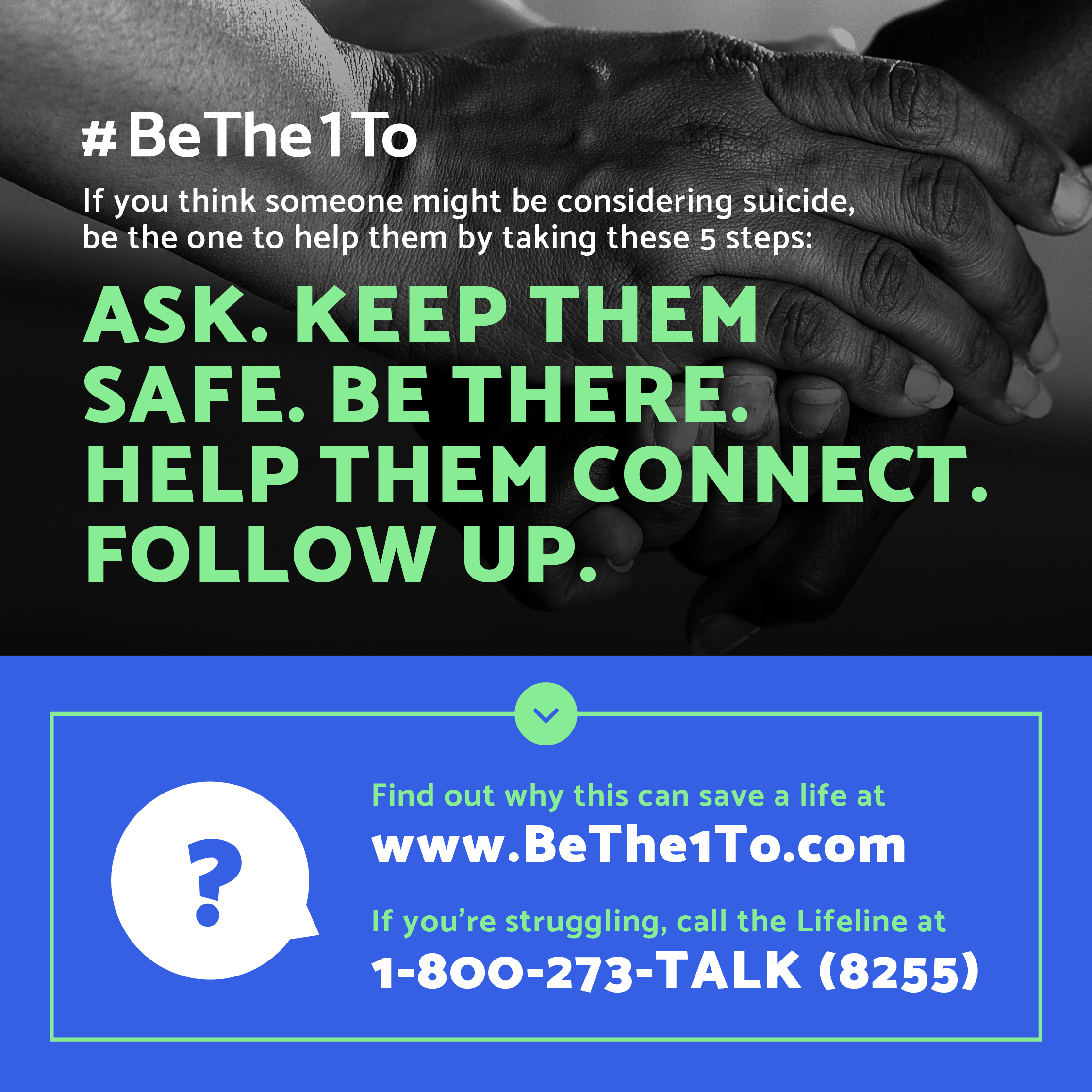Suicide
National Suicide Prevention Hotline - 1-(800)-273-8255
(in English, Spanish, and for Deaf & Hard of Hearing)
Suicide is currently the 12th leading cause of death for the general U.S. population and the second leading cause of death for people ages 10-14 and 25-34. Leaders in higher education - professors, administrators, etc. - and students alike must be vigilant when recognizing risk factors and personality traits for suicidal behavior.
Suicide - the act of intentionally causing one's own death or injuring oneself with the intent to die.
Suicide Attempt - when someone harms themselves with intent to end their life, but they do not die as a result of their actions.
Suicide Ideation - thinking about suicide or wanting to take your own life.
- Passive suicide ideation - wishing you were dead or that you could die but having no plans to commit suicide.
- Active suicide ideation - thinking about and having the intent to commit suicide, including planning on how to do it.
Suicide rates differ and vary by...
- Age
- Sexual identity
- Race and ethnicity
- Able and disabled persons
- Industry and occupation
- Geographical region (rural vs. urban areas)
Learn more about the disparities from the CDC HERE.
Being at risk for suicide is based on the behavior of the individual and their environment, including relationships, community, and societal factors:
Individual:
- Previous suicide attempt
- Mental illness, such as depression
- Social isolation
- Criminal problems
- Financial problems
- Impulsive or aggressive tendencies
- Job problems or job loss
- Legal problems
- Serious illness or chronic disease
- Substance use disorder
Relationship:
- Adverse childhood experiences such as child abuse and neglect
- Bullying
- Knowing someone who died by suicide, particularly a family member
- Relationship problems such as a break-up, violence, or loss
- Sexual violence
Community:
- Barriers to (behavioral) health care
- Cultural and religious beliefs (i.e., suicide is noble resolution of a personal problem)
- Suicide cluster in the community
Societal:
- Stigma associated with mental illness or help-seeking
- Easy access to lethal means among people at risk (e.g. firearms, medications)
- Unsafe media portrayals of suicide
Did you know that...
- On average, there are 130 suicides a day (1 death every 11 minutes).
- Suicide was responsible for 45,979 deaths in 2020.
- Each suicide intimately affects at least six other people.
- Firearms accounted for more than half (about 53%) of all suicide deaths.
- An estimated 12.2 million adults seriously thought about suicide, 3.2 million made a plan, and 1.2 million attempted suicide.
- Men have suicide rates 3.63 times higher than women.
- White males accounted for about 70% of suicide deaths.
- The rate of suicide is highest among middle-aged white men.
- 88% of young adults who died of suicide were male.
- 93% of surveyed adults in the U.S. believe suicide is preventable.
If you or someone you know is contemplating suicide, it might look like:
- Isolating from loved ones and close associates
- Feeling hopeless or trapped
- Talking about death or suicide
- Giving away possessions
- An increase in substance use or misuse
- Increased mood swings, anger, rage, and/or irritability
- Engaging in risk-taking behavior like using drugs or having unprotected sex
- Accessing the means to kill oneself, such as medication, drugs, or a firearm
- Acting as if you're saying goodbye to people
- Extreme anxiousness
Some major protective factors against suicide include:
- Effective behavioral health care (therapy or counseling)
- Connecting to individuals, family, community, and social institutions
- Building up your life skills (including problem solving skills and coping skills, ability to adapt to change)
- Bringing up your self-esteem
- Finding a sense of purpose or meaning in life
- Cultural, religious, or personal beliefs that discourage suicide
See the CDC's website for more suicide prevention resources.
The 5 Steps on How to Help Someone in Crisis
- Ask Them About It
- Giving a person the idea to commit suicide IS A MYTH. Research shows acknowledging and talking about suicide can decrease suicide ideation, and that people contemplating suicide feel relief when someone asks in a caring way.
- Be There
- Individuals are more likely to feel less depressed, less suicidal, less overwhelmed, and more hopeful after speaking to someone who listens without judgment.
- Keep Them Safe
- Separate them from anything they are thinking of using to hurt themselves. Make lethal means of suicide less available or less deadly.
- Help Them Stay Connected
- Create or get them to a network of resources and individuals for support and safety. You need more than one person to reach out to, or for them to reach out to, for help!
- Follow Up
- Check in with them on a regular basis. Ongoing contact is an important part of suicide prevention!
![]()


